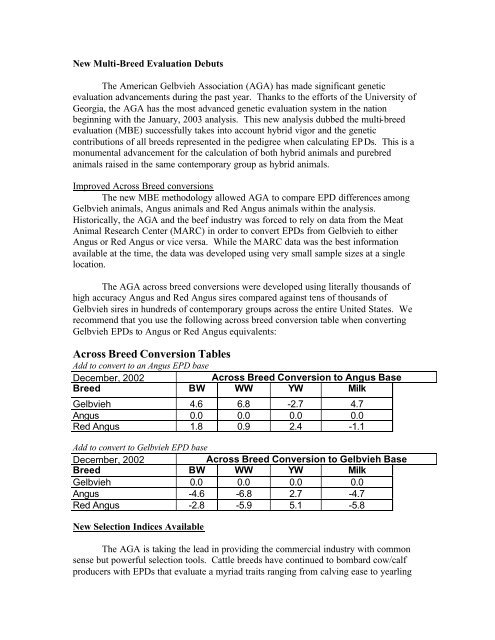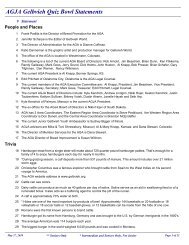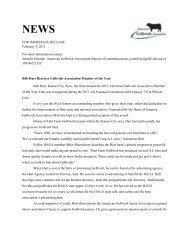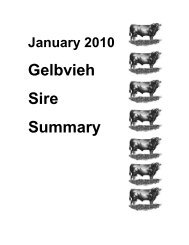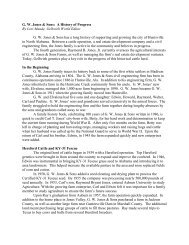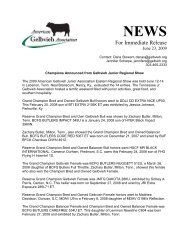New Multi-Breed Evaluation Debuts - American Gelbvieh Association
New Multi-Breed Evaluation Debuts - American Gelbvieh Association
New Multi-Breed Evaluation Debuts - American Gelbvieh Association
You also want an ePaper? Increase the reach of your titles
YUMPU automatically turns print PDFs into web optimized ePapers that Google loves.
<strong>New</strong> <strong>Multi</strong>-<strong>Breed</strong> <strong>Evaluation</strong> <strong>Debuts</strong><br />
The <strong>American</strong> <strong>Gelbvieh</strong> <strong>Association</strong> (AGA) has made significant genetic<br />
evaluation advancements during the past year. Thanks to the efforts of the University of<br />
Georgia, the AGA has the most advanced genetic evaluation system in the nation<br />
beginning with the January, 2003 analysis. This new analysis dubbed the multi-breed<br />
evaluation (MBE) successfully takes into account hybrid vigor and the genetic<br />
contributions of all breeds represented in the pedigree when calculating EPDs. This is a<br />
monumental advancement for the calculation of both hybrid animals and purebred<br />
animals raised in the same contemporary group as hybrid animals.<br />
Improved Across <strong>Breed</strong> conversions<br />
The new MBE methodology allowed AGA to compare EPD differences among<br />
<strong>Gelbvieh</strong> animals, Angus animals and Red Angus animals within the analysis.<br />
Historically, the AGA and the beef industry was forced to rely on data from the Meat<br />
Animal Research Center (MARC) in order to convert EPDs from <strong>Gelbvieh</strong> to either<br />
Angus or Red Angus or vice versa. While the MARC data was the best information<br />
available at the time, the data was developed using very small sample sizes at a single<br />
location.<br />
The AGA across breed conversions were developed using literally thousands of<br />
high accuracy Angus and Red Angus sires compared against tens of thousands of<br />
<strong>Gelbvieh</strong> sires in hundreds of contemporary groups across the entire United States. We<br />
recommend that you use the following across breed conversion table when converting<br />
<strong>Gelbvieh</strong> EPDs to Angus or Red Angus equivalents:<br />
Across <strong>Breed</strong> Conversion Tables<br />
Add to convert to an Angus EPD base<br />
December, 2002<br />
Across <strong>Breed</strong> Conversion to Angus Base<br />
<strong>Breed</strong> BW WW YW Milk<br />
<strong>Gelbvieh</strong> 4.6 6.8 -2.7 4.7<br />
Angus 0.0 0.0 0.0 0.0<br />
Red Angus 1.8 0.9 2.4 -1.1<br />
Add to convert to <strong>Gelbvieh</strong> EPD base<br />
December, 2002<br />
Across <strong>Breed</strong> Conversion to <strong>Gelbvieh</strong> Base<br />
<strong>Breed</strong> BW WW YW Milk<br />
<strong>Gelbvieh</strong> 0.0 0.0 0.0 0.0<br />
Angus -4.6 -6.8 2.7 -4.7<br />
Red Angus -2.8 -5.9 5.1 -5.8<br />
<strong>New</strong> Selection Indices Available<br />
The AGA is taking the lead in providing the commercial industry with common<br />
sense but powerful selection tools. Cattle breeds have continued to bombard cow/calf<br />
producers with EPDs that evaluate a myriad traits ranging from calving ease to yearling
performance to stayability to a whole host of carcass traits. The result is that in our effort<br />
to provide cow/calf producers with all of these EPDs, we have many times overwhelmed<br />
them with too much data.<br />
The dairy industry in the United States has been using a simplified technology<br />
that incorporates EPDs from several traits, weights the traits based on economic value,<br />
and produces a single economic index for the group of traits. These selection indices are<br />
presented as dollar values. As an example, you can compare two dairy bulls based on the<br />
dollars of milk that bulls daughter’s are expected to produce.<br />
The AGA established a goal in our 24-month plan to produce 3 indices for each<br />
segment of the industry (cow/calf, feedlot, carcass). The AGA has released two indices<br />
over the past two years… the Grid Merit EPD and the Feedlot Merit EPD. The AGA is<br />
still in development of the Cow/calf Merit EPD.<br />
The Grid Merit EPD<br />
As with other EPDs, index EPDs are used to estimate how future progeny of one<br />
animal compare to progeny of another animal within the same breed. Dr. Patrick Doyle,<br />
currently with Chico State University and former AGA Director of Education,<br />
spearheaded the design and release of the Grid Merit EPD in 2002. The Grid Merit EPD<br />
measures the dollar value associated with marketing progeny on a value-based grid.<br />
Specifically, the Grid Merit EPD predicts the carcass value associated with selling<br />
carcasses on a grid based on quality grade, yield grade and fitting weight specifications.<br />
As an example, a bull with a Grid Merit EPD of $12 is expected to sire calves that when<br />
marketed on a “typical” grid will average $12 higher in carcass value than calves sired by<br />
a bull with an EPD of $0. The Grid Merit EPD was refined with the release of the 2003<br />
sire summary to remove the impact of carcass weight in the calculation. The value of<br />
gain is more accurately reflected in the new Feedlot Merit EPD.<br />
The Feedlot Merit EPD<br />
The Feedlot Merit EPD was recently released as part of the 2003 <strong>Gelbvieh</strong> genetic<br />
evaluation. Tom Brink, former AGA executive director, performed the research and<br />
development of this index. Like the Grid Merit EPD, the Feedlot Merit EPD is expressed<br />
in dollars. Specifically, the Feedlot Merit EPD measures the dollar value associated with<br />
the expected gain and feedlot efficiency of progeny when fed in a “typical” feedlot<br />
arrangement. As an example, a bull with Feedlot Merit EPD of $15 is expected to sire<br />
calves that will perform $30 per head better than calves sired by a bull with an EPD of $-<br />
15.<br />
The AGA continues to work towards providing the industry with the best genetic<br />
predictions in the country. The new MBE analysis offered by the AGA is the new<br />
standard of excellence for beef industry genetic evaluations.


